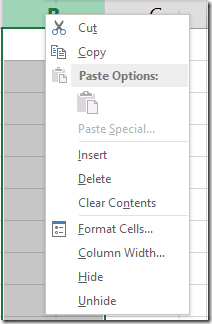So far I have written 139 articles. There are thousands of features yet to be covered. There is another skill you need to learn – the ability to learn to learn!
In this article, I will demonstrate a simple method of learning. Usually, learning requires reading help files, books or visiting web sites. This method just uses mouse Right Click. Read on and find out how powerful this method is…
Contents
The simple mantra – Right Click to learn more
- What happens when you right click?
- A menu appears – called the Right Click menu.
- So what do you do next?
- Just read the options from top to bottom.
- Think a little about each option.
If you understand what it does – move on. - If something is not clear, try it out.
- That’s all.
Is that all? Sounds too simple… Well, IT IS simple.
The menu changes …
There is no catch. It is just that the menu which appears on right click changes depending upon where you clicked. Why so?
Here is an example.
Right clicking in an Excel cell B2 shows this menu.
Even if you have seen it before, just go through each option and see how many of them you have missed till date.
Notice the Delete… option. If you click it, Excel does not know what exactly you want to delete – row or column. So it will ask for that information from you. That is what the ellipsis… indicate.
Now right click on a column header and compare the menu… See that it has shrunk considerably. Some options like Copy, Paste are still there. But many irrelevant options were removed.
Notice that the Delete option is still there but the three dots are gone. Why so? Because Excel now KNOWS that you right clicked on a column. Which tells Excel that if you choose Delete, you want to delete the entire column. There is no question of deleting a Row here.
This is what I mean by context sensitive menu. The technical name for Right Click menu is actually Context Menu.
It is assembled based upon where you right clicked.
These options are anyway available in the standard menu (ribbon). So what is the big deal?
Agreed. Most (if not all) options shown in the right click menu are available elsewhere in the menus. The difference is that the options in ribbon are always available. They are too many to read, decipher and learn. You don’t know which option to choose in what context or scenario.
When you right click, all the options you see are GUARANTEED to be useful and relevant in the current context. That way, you get a reassurance that reading and knowing them will help you immediately.
When should you try a right click?
Apart from the standard use of right click – to get to an option you already know – here are more reasons to do so…
- When you want to get something done but don’t know how to do it
- When you want to explore and learn
- When you know the answer but want to check if there is a better solution available
- Whenever mouse cursor shape changes, it is worth Right Clicking
Mouse cursor changes when the context changes. And when the context changes the right click menu also changes
Using a touch device?
No problem, extended touch is the right click menu. Notice that if you are using Office 2013, the menu changes depending upon you used mouse (or styles) or your finger to invoke the menu. Brilliant – is it not?
Go ahead and learn more
Try it for a day and post your feedback here. Did you find new items, did you learn more?





